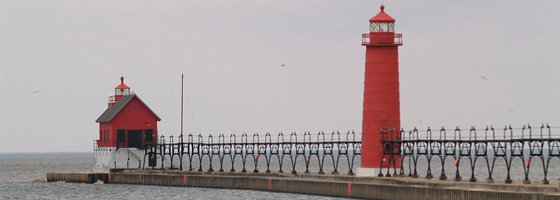Great Lakes buoy project turns to communities for long-term funding

A Great Lakes buoy set to be deployed in summer 2013 will provide nearshore weather data to communities and the National Weather Service. Project managers say the buoy will make local communities safer by warning of dangerous storm conditions.
LimnoTech, an environmental engineering and consulting firm in Ann Arbor, Mich., has been chosen to deploy and maintain the buoy. The project is being overseen by the Great Lakes Observing System and funded through the National Oceanic and Atmospheric Association’s Coastal Storms Program, which expanded to the Great Lakes area in 2012. Plans are to station the new buoy near Grand Haven, Mich.
“We will not be recording statistics directly, rather this project will provide ten minute average observations of physical conditions,” said Ed Verhamme, project engineer at LimnoTech.
Those measurements – including air temperature, pressure and relative humidity; water temperature, wave height, period and direction; and wind speed and direction – will be transmitted to the observing system and NOAA. Both organizations have portals that archive data and allow users to view current and historical meteorological conditions. The National Weather Service will also use the data to make better weather forecasts and warn of hazardous conditions.
“GLOS maintains an observations explorer and database that receives data from the buoy and provides an interactive display of data and model forecasts,” Verhamme said. “In addition, GLOS provides resources to connect other buoy owners and operators to share resources.”
Verhamme said LimnoTech is responsible for all aspects of buoy acquisition, mooring and deployment, as well as taking care of permits and any needed maintenance. But the long-term funding for the buoy will work differently than past projects.
“Rather than just provide funds to deploy a buoy for a specified number of years, this project also includes funds to reach out to the local community to engage them and identify sustainable sources of funding to keep the buoy deployed,” Verhamme said.
That could signal a change in the way future observing systems are funded.
“I believe this project represents a small shift in the way that GLOS and others are viewing the funding of observing systems across the Great Lakes,” Verhamme said. “While federal funds are used to get the project going, it will be up to the community to decide if they want to continue to fund this local observing system past the end of the project.”
According to Verhamme, thousands of people access information from buoys on an almost daily basis. While fishermen, boaters or other individuals might not be able to fund a buoy’s operation by themselves, he said the Grand Haven buoy should be able to remain deployed after funding ends by pooling local resources.
“A goal of this project is also to engage local organizations in the next three years so that when the grant ends, local groups could take over funding, deployment and retrieval,” Verhamme said.
“By partnering with local organizations, we can develop a sustainable funding model that doesn’t rely on continual grant funding to keep a nearshore buoy deployed off of Grand Haven.”
The buoy will differ from other ones near Great Lakes shores that are mostly for research and maintained by universities.
Verhamme explained, “Another unique aspect of this project is that its primary purpose is to provide observations of lake conditions for a very specific nearshore area and to share that data freely with the public.”
Image: The Lake Michigan coast at Grand Haven, Mich., near where the buoy will be stationed (Credit: takomabibelo, via Flickr)




0 comments